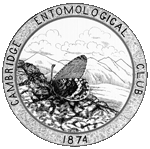
| January 2008: Psyche has a new publisher, Hindawi Publishing, and is accepting submissions |
An Australian Trapeiopelta (Hemenoptera: Formicidae).
Psyche 60:51, 1953.
Full text (searchable PDF, 80K)
Durable link: http://psyche.entclub.org/60/60-051.html
The following unprocessed text is extracted from the PDF file, and is likely to be both incomplete and full of errors. Please consult the PDF file for the complete article.
19531 FuirchildÌÔMexica Tabanidae 51
difficult to separate pumiloides and subtilis from the de- scriptions. Both were described from Mexico, pumiloides from Guerrero and Jalisco, subtilis from Oaxaca. Direct type comparisons will be needed to achieve certainty in this difficult group, but the present species is separable on color characters at least.
REFERENCES
STONE, A.
1938. Horseflies of the subfamily Tabaninae of the Nearctic region. U.S.D.A. Misc. Pub. 306: 1-171, 79 figs. PHILIP, C. B.
1941. Comments cm the supra-specific categories of Nearctic Tabanidae. Can. Ent., 73: 1-14.
AN AUSTRALIAN TRAPEZIOPELTA (HYMENOPTERA : FORM- ICIDAE) . - Specimens of Trapeziopelta collected by me at Mt. Dandenong (2000 feet) and Olinda (1600 feet) under stones in grassy-floored moist sclerophyll (eucalypt) forest, Dandenong Ranges, Victoria, Australia compare very closely with the types of Myopias tasmaniensis Wheeler (1923, Psyche, 30: 177-179, fig. I, worker), kept in the Museum of Comparative Zoology at Harvard University. My series also compared equally well with types of Trap- eziopelta diadela Clark (1934, Mem. Nat. Mus., Melbourne; No. 8: 54-55, pi. 4, figs. 7, 8, worker and female). All of the specimens concerned belong to one species, which is correctly assigned to Trapeziopelta on the basis of the clypeal structure. The correct name of the species is there- fore Trapeziopelta tasmaniensis (Wheeler), new combin- ation, and T. diadela Clark is its new synonym. The species is now known from widely separated localities in Tasmania and southern Victoria, where it appears to prefer higher- rainfall sclerophyllous forest.
At least two other species of Trapeziopelta, remaining unstudied, occur in southeastern and northeastern Queens- land. - W. L. BROWN, JR., Museum of Comparative Zo- ology, Harvard University.
================================================================================
Volume 60 table of contents